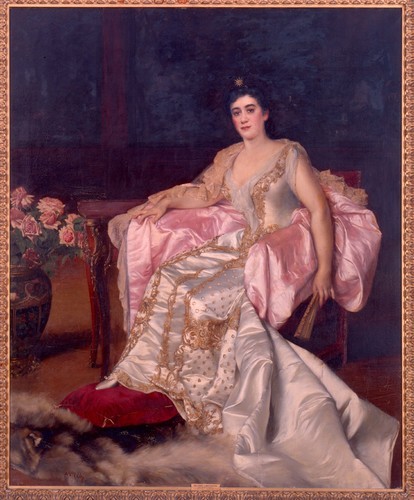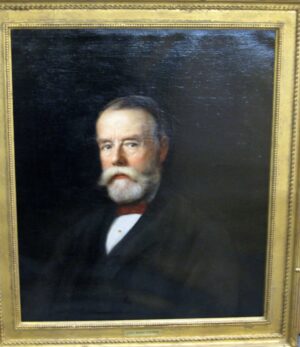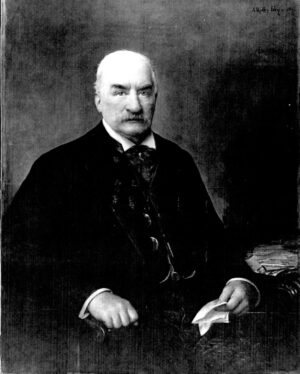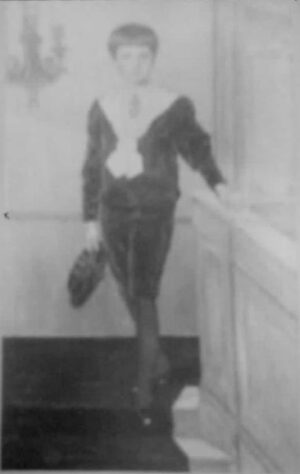HAVEMEYER, Mrs Theodore (Emilie de Loosey) (1891)
Description:
Described in The New York Press, August 9, 1891 as follows: ‘Apropos of portraits, one of the most superb ever painted in this city, or indeed for that matter in any other, is one of Mrs. Theodore Havemeyer which A. Muller-Ury has just completed. Mrs. Havemeyer who is a regal looking brunette, is seated in a carved armchair resting one beautiful bare arm upon a table. She wears a gown of white satin embroidered thickly with gold, and she has just thrown back, from her bare white shoulders a splendid opera cloak of pink velvet lined with the most exquisitely tinted pinkish mauve silk. The textures of the three materials are rendered with phenomenal skill. Mrs. Havemeyer’s foot rests upon a crimson velvet cushion, and in the corner of the canvas opposite to where Mrs. Havemeyer sits in queenly state stands a superb jar about three feet high filled with gorgeous La France roses, whose perfume you are almost sure you smell, so perfect are they. The picture’s background is a rich red portiere. The composition is inexpressibly poetic, and yet there is not even a suspicion of striving after theatrical effect. The surroundings are just such as Mrs. Havemeyer’s friends are accustomed to seeing her among, and the portrait is a wonderful one as to resemblance. It is a great pity it cannot be exhibited, for a sight of it would be a liberal education to many a portrait painter.’
Oil on canvas, 85” x 70” (215.9 x 177.8 cms). Signed and dated ‘A. Muller-Ury 1891’ lower left.
Location:
The Preservation Society of Newport County, Rhode Island. Hung in Rosecliff in 1993.
Provenance:
Gift from the Havemeyer family after the death of H.O. Havemeyer Sr. in 1965.
Exhibitions:
(a.) It was first exhibited to an invited throng at the artist’s studio at 58 West 57th Street, New York, on Tuesday and Wednesday, January 12 and 13, 1892, along with portraits of Cardinal Gibbons, Chauncey M. Depew, Captain Gilbert Wiltze, Miss Benziger and Master J. J. Seligman.
(b.) On January 28, 1892, the Havemeyers gave a dinner at their residence at 244, Madison Avenue, where it was exhibited in the marble hall at the entrance to the art gallery. The World, New York, Sunday, January 31, 1892 added that on that evening Mrs. Havemeyer ‘wore the same white brocaded satin gown in which it was painted, and everyone had a chance to judge of the artist’s ability as a photographer.’
(c.) THE NATIONAL ACADEMY OF DESIGN, New York, ‘Loan Exhibition of Women’s Portraits’, November 1894.
(d.) FRENCH & CO. INC., 210, East 57th Street, New York, April 21 – May 3, 1947, No. 17.
Bibliography:
Once a Week, April 7, 1891
The Epoch, New York, Vol. IX, No. 231, 10 July 1891, p. 361-362.
The Press, New York, Sunday, August 9, 1891
The Tribune, Sunday, August 16, 1891
The Collector, Vol. 2, No. 18, September 1, 1891
New York Commercial Advertiser, September 5, 1891
Harpers Bazaar, New York, September 12, 1891
The Mail and Express, New York, Thursday, January 14, 1892
Evening Post, New York, January 16, 1892
Mail and Express, New York, Tuesday evening, January 26, 1892 (Line illustration)
Mail and Express, New York, Friday evening, January 29, 1892
New York Daily News, January 30, 1892
The World, Sunday, January 31, 1892
The New York Tribune, February 1, 1892
Evening Telegram, New York, February 16, 1892
Home Journal, New York, Wednesday, February 17, 1892
The Social Truth, Saturday, April 23, 1892.
Godey’s Magazine, January 1893
Die Ostschweiz, St. Gallen, Switzerland, February 13, 1894
Urner Wochenblatt, Altdorf, Switzerland, February 17, 1894
New York Commercial Advertiser, March 14, 1894
New York Commercial Advertiser, April 24, 1894
New York Commercial Advertiser, April 25, 1894
Mail and Express, New York, Thursday evening, April 26, 1894
Town Topics, April 26, 1894
The Illustrated American, October 27, 1894, p. 516 (reproduced)
New York World, Sunday, October 28, 1894 (Line illustration)
New York Recorder, November 1, 1894
New York Morning Advertiser, November 2, 1894
New York Daily News, November 4, 1894
New York Herald, Friday, November 30, 1894
FORM, New York, May 1895, Vol. 1, No. 3
The American University Magazine, May 1895, Vol. II, No. 1
Jessica Dragonette, Faith is a Song: The Odyssey of an American Artist, 1951, p. 300.
Alexis Gregory, ‘Society Portraits’ in The Magazine Antiques, April 1995, Vol.CXLVII, no.4, pp. 606-609, Pl.VI, reproduced in colour.
The sitter (1844-1914), daughter of Chevalier Charles F. de Loosey, the Austrian Consul-General to New York, was the wife of Theodore A. Havemeyer (1839-1897), and sister of Mrs. Charles Oelrichs (Blanche de Loosey). She had nine children, five daughters and four sons:
1. Nathalie Ida Blanche Havemeyer (1864–1900), who married John Mayer.
2. Emily Blanche Havemeyer (b. 1865), who married Edward Clarkson Potter (1862-1950)
3. Charles Frederick Havemeyer (1867–1898), who married to the noted beauty Camilla Woodward Moss (1869-1934) and became well known in New York Society, being listed in Ward McAllister’s first ‘400’.
4. Theodore Augustus Havemeyer, Jr. (b. 1868)
5. Blanche Maximillian Havemeyer (1871–1958), who married William Butler Duncan, Jr.
6. Marie Ida Pauline Havemeyer (1872–1925), who married Perry Tiffany (1866–1928) and H. F. Godfrey.
7. Henry Osborne Havemeyer II (died 1965), who became a major financier of Stephen Birch and the future Kennecott Copper Company.
8. Theodora Havemeyer (1878–1945), who married Admiral Cameron McRae Winslow (1854–1932)
9. Frederick Christian Havemeyer (b. 1879), who married Lillie Harriman (b. 1870), daughter of Oliver H. Harriman.
She maintained four residences after the death of her husband in 1897, which included one each in France and Switzerland. Hopelessly extravagant, when she died in Montreux, Switzerland, in May 1914 – despite her husband having made ample provision for her – she was in debt for a million dollars. In her sale in 1914 there were several pictures by Muller-Ury which were not family portraits, including one called ‘Marguerite’.
According to Once a Week of April 7, 1891 Mrs. Havemeyer commissioned this portrait herself, though this seems unlikely.
The Collector, September 1, 1891, adds to its encomium the following comment on the artist’s skills: ‘…The pink velvet and the mauve silk lining of the cloak make a delicate harmony with the creamy brilliancy of the satin, and give a palpitant substantiality to the finely modelled flesh…The color is admirably vital, and the handling broad, strong and finished without any enfeebling effort at extreme polish.’
The portrait was the picture which gave Muller-Ury his initial success in America. It was apparently exhibited publicly only once in the 1890s, which is curious, but it was frequently mentioned in the newspapers, as the Bibliography attests. At that showing at the National Academy of Design, one newspaper reported (unfortunately the cutting in the artist’s papers is not labelled) that: ‘The painting which excited perhaps the most admiration was that of Mrs. Theodore Havemeyer, by Muller-Ury. This painting, which is in the southern gallery, kept a constant crowd of admirers about it.’
The Epoch, New York, Vol. IX, No. 231, 10 July 1891, p. 361-362, states that the picture had been sent to Newport and measured 7 x 5 1/2.
In her auto-biography Faith is a Song (1951) Jessica Dragonette claims (p.300) that he was only nineteen when he painted this – a misunderstanding since he was actually 29 years old. Jessica and her sister Mrs. Rosalinda (Nadea) Loftus organised the artist’s last exhibition in which this was included. In a letter to Mrs. Loftus dated February 23, 1966 (original in the author’s possession) after the death of his father H.O. Havemeyer Jr. wrote ‘…If you…desire to purchase this very fine portrait, I suggest you offer $2,500.- for an immediate sale. This figure is only one sixth of the original price of $15,000.- paid for it’s execution in 1891.’
Further Notes:
The New York Times, in its review of Muller-Ury’s exhibition at THE DURAND-RUEL GALLERIES, 389, Fifth Avenue, New York, March 1 – 15, 1897, says that ‘a fancy portrait of Mrs. Theodore Havemeyer is also noticeable for its delicacy of colour,’ but it is not clear if this is the picture now in Rhode Island or another lost picture. It is not mentioned in the other review cuttings.
American Art News, Vol. 3. No. 63, New York, January 21st, 1905, p. 2, says a study hangs in his Sherwood studio, but this is almost certainly the photograph he framed and hung on a screen beside which he was photographed in his costume for the Bradley Martin Ball in 1897 and is visible in the 1894 studio photograph.





